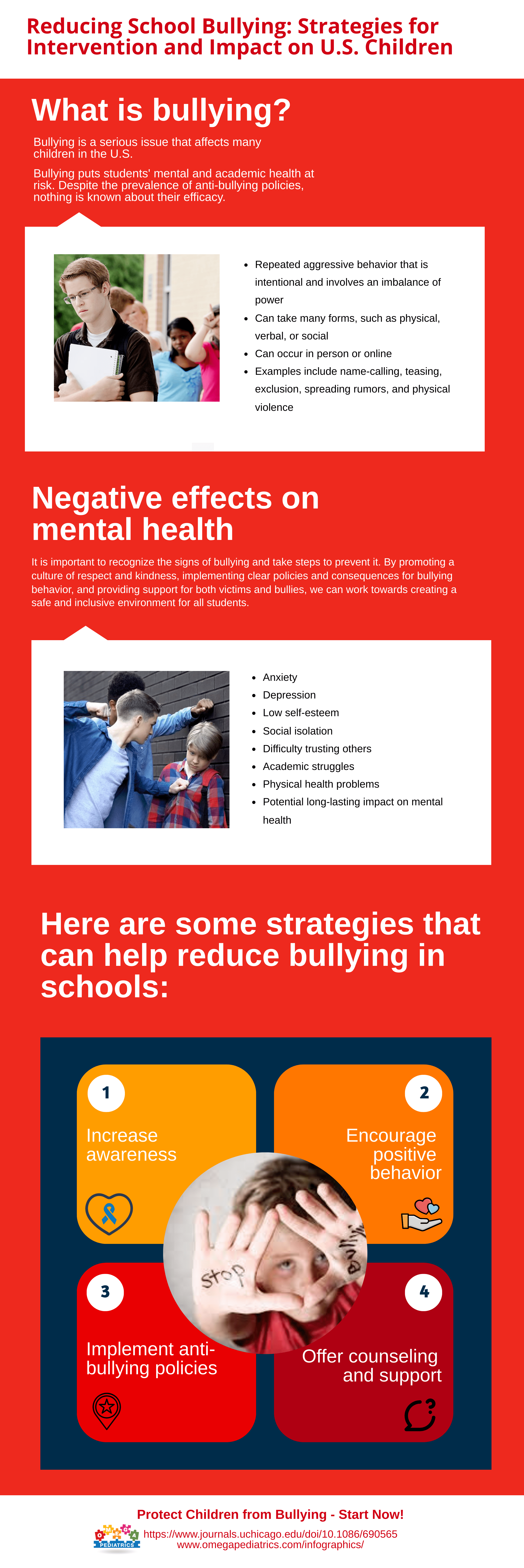
Bullying is a serious issue that affects many children in the U.S. Here are some strategies that can help reduce bullying in schools:
- Increase awareness: Schools can increase awareness of bullying by educating students, teachers, and parents about the impact of bullying and how to recognize and report it.
- Encourage positive behavior: Schools can promote positive behavior and encourage students to treat each other with respect and kindness through programs such as character education and positive reinforcement.
- Implement anti-bullying policies: Schools can implement anti-bullying policies that outline clear consequences for bullying behavior and provide support for victims.
- Offer counseling and support: To address the underlying issues that contribute to bullying behavior, schools can offer counseling and support services for both the victims of bullying and the bullies themselves.
- Promote diversity and inclusivity, address prejudice and discrimination, and give kids a secure space to express themselves in order to create a safe and welcoming learning environment in schools.
The National Center for Education Statistics estimates that 20% of American students reported experiencing bullying at school in the 2018–19 academic year. Effective intervention techniques can drastically lower this percentage and improve the safety and climate of the classroom for all students.
What is bullying:
Bullying puts students’ mental and academic health at risk. Despite the prevalence of anti-bullying policies, nothing is known about their efficacy.
- Repeated aggressive behavior that is intentional and involves an imbalance of power
- Can take many forms, such as physical, verbal, or social
- Can occur in person or online
- Examples include name-calling, teasing, exclusion, spreading rumors, and physical violence
Negative effects on mental health:
- Anxiety
- Depression
- Low self-esteem
- Social isolation
- Difficulty trusting others
- Academic struggles
- Physical health problems
- Potential long-lasting impact on mental health
It is important to recognize the signs of bullying and take steps to prevent it. By promoting a culture of respect and kindness, implementing clear policies and consequences for bullying behavior, and providing support for both victims and bullies, we can work towards creating a safe and inclusive environment for all students.
Fostering a Supportive Community
Creating a culture of support and camaraderie within schools is crucial to mitigating bullying. This involves building a sense of community that extends beyond the classroom walls. By fostering a supportive environment, schools can further reduce the instances of bullying. Here’s how:
1. Establish Peer Support Programs:
Encourage the formation of peer support programs where older students mentor younger ones. This not only helps younger students feel more secure but also promotes positive relationships among peers. These programs can provide a platform for open communication and the sharing of experiences, fostering empathy and understanding.
2. Empower Bystanders:
Educate students about the importance of being active bystanders. Encourage them to speak up against bullying and report incidents to teachers or school authorities. By empowering bystanders, schools can create a collective responsibility for maintaining a safe and respectful environment.
3. Strengthen Parental Involvement:
Involve parents in anti-bullying initiatives. Hold workshops and seminars to educate parents about bullying, its signs, and ways to support their children. When parents and schools work together, a stronger support network is created, reinforcing the message that bullying is not tolerated.
4. Incorporate Restorative Justice Practices:
Implement restorative justice practices that focus on repairing harm rather than punishing the perpetrator. This approach encourages dialogue between the victim and the bully, fostering understanding and empathy. It can be a transformative process that addresses the root causes of bullying.
Conclusion:
Bullying is a complex issue that requires a multifaceted approach. By increasing awareness, promoting positive behavior, implementing policies, offering support services, and fostering a supportive community, schools can significantly reduce the prevalence of bullying. The negative effects of bullying on mental health and academic performance underscore the urgency of addressing this issue.
It is essential for educators, parents, and students to collaborate in creating an inclusive and respectful environment. Through continuous efforts to raise awareness, instill positive values, and provide necessary support, we can cultivate a school culture where bullying is not tolerated, and every student feels safe and valued. By taking these steps, we contribute to the well-being of our students and pave the way for a brighter, more inclusive future in our educational institutions.



